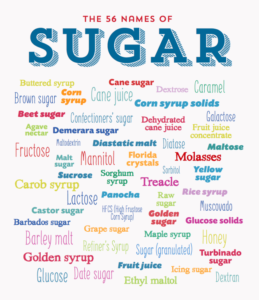My research for this series has been eye opening, I knew added sugar was bad for you but I didn’t know how bad. I even left out the studies that lacked serious credibility even though they were very plausible. First let’s look at the different types of sugars. The three different single molecule sugars can combine to make two molecule sugars. The main sugars we are concerned with are glucose and fructose which combine to make sucrose or what we call table sugar. Glucose is the fuel for our brain and many of the metabolic reactions in the body. Fructose is the sweet taste in fruit and when eaten in fruit does not have a negative effect. However when fructose is eaten by itself or combined with glucose to make sucrose it causes fatty liver and insulin resistance. (1) By the way High Fructose Corn Syrup usually has between 44-55% fructose while sucrose is always 50% fructose so the fructose content is not really the problem with this sweetener. (1) The real problem with HFCS is it is really cheap and easy to store and transport so it gets used in so many things.
That leads to point two. Sugar is everywhere. 73.5% of all foods sold in American stores contain ADDED sugar. Most of this is added because of our addiction to sweet so we will buy more. Also much of this is hidden under different names. Also although naturally occurring sugar in the food is okay using a sugar derived from the food as a sweetener is still just as bad as plain old sugar.
It is accepted that sugar consumption can cause Type 2 diabetes, high blood pressure, high cholesterol, and heart attack also referred to as metabolic syndrome. Yet most of us think this only applies to obese people but that’s not true. While about 20% of obese people don’t have metabolic syndrome about 40% of non obese people DO have metabolic syndrome. Many of these thin people have type 2 diabetes and don’t know it. A common thread is sugar consumption. If you drink one sugar soda every day your risk of developing type 2 diabetes goes up 18% regardless of body size. For those of you who are smug in the fact you only drink diet sodas your risk goes up 25%. (Note part of the reason this number is higher is more obese people drink diet soda but artificial sweeteners have been shown to cause obesity and insulin resistance.) (3)
The evidence is clear. We must cut back on ADDED sugar. Tomorrow I will give some ideas for lowering your sugar intake.
- Basu S, Yoffe P, Hills N, Lustig RH (2013) The Relationship of Sugar to Population-Level Diabetes Prevalence: An Econometric Analysis of Repeated Cross-Sectional Data. PLoS ONE 8(2): e57873. doi:10.1371/journal.pone.0057873
- Ng SW, Slining MM, Popkin BM. Use of caloric and non-caloric sweeteners in US consumer packaged foods, 2005–9. Journal of the Academy of Nutrition and Dietetics. 2012;112(11):1828-1834.e6. doi:10.1016/j.jand.2012.07.009.
- Imamura Fumiaki, O’Connor Laura, Ye Zheng, Mursu Jaakko, Hayashino Yasuaki, BhupathirajuShilpa N et al. Consumption of sugar sweetened beverages, artificially sweetened beverages, and fruit juice and incidence of type 2 diabetes: systematic review, meta-analysis, and estimation of population attributable fraction BMJ 2015; 351 :h3576
- Metabolic Syndrome in Normal-Weight Americans
Marie-Pierre St-Onge, Ian Janssen, Steven B. Heymsfield
Diabetes Care Sep 2004, 27 (9) 2222-2228; DOI: 10.2337/diacare.27.9.22

